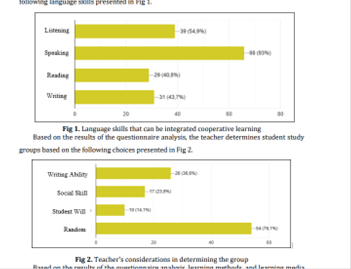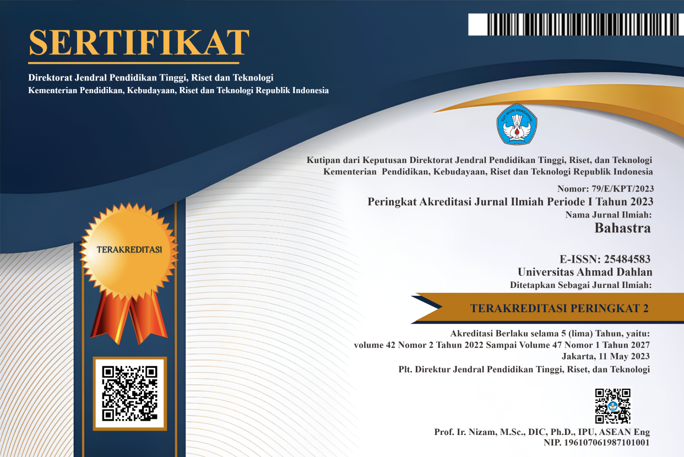Cooperative learning in online distance learning: Teacher response
DOI:
https://doi.org/10.26555/bs.v42i2.231Keywords:
Online Learning; Distance Learning; Cooperative Learning; COVID-19; Teachers ResponseAbstract
It has been almost two years that learning has been carried out online, resulting in students being less social and learning is dominated by individual learning. Therefore, it is necessary to apply group learning to overcome this. However, these lessons cannot be simply applied and need to be analyzed. One of these analyzes is to find out the responses of students and teachers. The purpose of this study was to describe the perceptions of teachers regarding cooperative learning during online distance learning during the COVID-19 pandemic. This research is a descriptive research using survey method. The research instrument was in the form of a questionnaire filled out by 71 teacher respondents. The results showed that several important aspects of cooperative learning were the number of group members, group determination, the media used, and group assessment.
References
Afinda, B. N., Aisyah, R. S. S., & Wijayanti, I. E. (2019). Student team achievement division (STAD) dengan word square: Dampaknya terhadap motivasi dan hasil belajar. JIPVA (Jurnal Pendidikan IPA Veteran), 3(1), 17—27. Doi: 10.31331/jipva.v3i1.773.
Akyıldız, S. T. (2020). College students’ views on the pandemic distance education: A focus group discussion. International Journal of Technology in Education and Science (IJTES), 4(4), 322-334. Doi: 10.46328/ijtes.v4i4.150.
Anjum, S., Bhatti, R. U., & Iqbal, M. J. (2020). A study of communication barriers in open distance learning system of education. Pakistan Journal & Online Learning, 6(1), 247-261. https://eric.ed.gov/?id=EJ1301966.
Arifin, Z., Febriani, S. R., & Anasruddin (2021). Using Bloom’s Taxonomy in Arabic learning media to elevate student’s writing in Covid-19 situation. Al-Ta’rib, 9(1), 1-12. https://doi.org/10.23971/altarib.v9i1.2530.
Berlyana, M. D. P., & Purwaningsih, Y. (2019). Experimentation of STAD and Jigsaw Learning Models on learning achievements in terms of learning motivation. International Journal of Educational Research Review, 4(4), 517-525. Doi: 10.24331/ijere.628311.
Bozkurt, A., & Sharma, R. C. (2020). Emergency remote teaching in a time of global crisis due to Corona Virus pandemic. Asian Journal of Distance Education, 15(1).
Cohen, V. L. (2003). Distance learning instruction: A new model of assessment. Journal of Computing in Higher Education, 14(2), 98–120. Doi: 10.1007/BF02940940.
Damopolii. I., & Rahman. S. R. (2019). The effect of STAD learning model and science comics on cognitive students achievement. Journal of Physics: Conference Series, 1157, 1-6. Doi: 10.1088/1742-6596/1157/2/022008.
Daniel, S. J. (2020). Education and the COVID-19 Pandemic. Prospects, 49. Doi: 10.1007/s11125-020-09464-3.
Davis, L. N., Gough, M., & Taylor, L. L. (2019) Online teaching: Advantages, obstacles and tools for getting it right. Journal of Teaching in Travel & Tourism, 19(3), 256-263. Doi: 10.1080/15313220.2019.1612313.
Demuyakor, J. (2021). COVID-19 Pandemic and higher education: Leveraging on digital technologies and mobile applications for online learning in Ghana. Shanlax International Journal of Education, 9(3), 26-38. Doi: 10.34293/education.v9i3.3904.
Dios, M. T., & Charlo, J. P. (2021). Face-to-Face vs. E-Learning Models in the COVID-19 Era: Survey Research in a Spanish University. Education Sciences, 11, 1-18. Doi: 10.3390/educsci11060293.
Eroğlu, M. & Şenol, C. (2021). Emergency remote education experiences of teachers during the Covid-19 pandemic: A phenomenological research. Shanlax International Journal of Education, 9(3), 161-172. Doi:10.34293/education.v9i3.3918.
Fincham, D. (2017). Implications and challenges in studying as a full distance learner on a masters programme: Students’ perspectives. International Journal of Higher Education, 6(1), 34–47. Doi: 10.5430/ijhe.v6n1p34.
Güneş, S., & Alagözlü, N. (2020). The interrelationship between learner autonomy, motivation and academic success in asynchronous distance learning and blended learning environments. Novitas-Royal, 14(2), 1-15. https://eric.ed.gov/?id=EJ1272398.
Hijriah, E. M., Darmawan, E., & Zamzami, M. R. A. (2018). Enhancing biology students motivation through classroom action research based STAD learning model. Indonesian Journal of Biology Education, 1(1), 9-16. Doi: 10.31002/ijobe.v1i1.996.
Jacobs, G. M., & Ivone, F. M. (2020). Infusing cooperative learning in distance education. Teaching English as Second or Foreign Language, 24(1), 1-15.
Juliastuti, I. P., Dyah, W. E., & Surini, H. (2019). Peningkatan pemahaman konsep pecahan pembelajaran tema cuaca melalui model cooperative learning tipe STAD dan media origami pada kelas 3A SDN Purwantoro 2 Malang. Jurnal Basicedu, 3(1), 130-135. Doi: 10.31004/basicedu.v3i1.103.
Khan, G. N., & Inamullah, H. M. (2011). Effect of student’s team achievement division (STAD) on academic achievement of students. Asian Social Science, 7 (12), 211-215. Doi: 10.5539/ass.v7n12p211.
Kim, D. (2018). A study on the influence of Korean middle school students’ relationship through science class applying STAD cooperative learning. Journal of Technology and Science Education, 8(4), 291-309. Doi: 10.3926/jotse.407.
Kuleshova, V. V., Kutsak, L. V., Liulchak, S. Y., Tsoi, T. V., & Ivanenkom I. V. (2020). Implementation of modern distance learning platforms in the educational process of HEI and their effectiveness. International Journal of Higher Education, 9(7), 217-229. Doi: 10.5430/ijhe.v9n7p217.
Landicho, C. J. B. (2021). Changes, challenges, and opportunities in teaching senior high school earth science amidst the COVID-19 Pandemic. Journal of Learning and Teaching in Digital Age, 6(1), 55-57. https://eric.ed.gov/?id=EJ1285388.
Lantajo, J. T. (2017). The use of STAD model in teaching chemistry: Its effect to students’ academic performance. International Conference on Studies in Business, Management, Education, and Law (SBMEL-17) (169–173).
Mailizar, Almanthari, A., Maulina, S., & Bruce, S. (2020). Secondary school mathematics teachers’ views on e-learning implementation barriers during the Covid-19 pandemic: The case of Indonesia. Eurasia Journal of Mathematics, Science and Technology Education, 16(7). Doi: 10.29333/ejmste/8240.
Maslova, I., Burdına, G., & Krapotkina, I. (2020). The use of electronic educational resources and innovative educational technologies in university education. International Journal of Emerging Technologies in learning, 15 (16), 68-79. Doi: 10.3991/ijet.v15i16.14909.
Meulenbroeks, R. (2020). Suddenly fully online: A case study of a blended university course moving online during the Covid-19 pandemic. Heliyon, 6(12). Doi: 10.1016/j.heliyon.2020.e05728.
Murtiyasa, B., & Hapsari, S. N. (2020). The effect of TAI and STAD strategy towards learning outcomes reviewed from mathematical communication skill. Universal Journal of Educational Research, 8(6), 2406-2415. Doi: 10.13189/ujer.2020.080625.
Noreen, S. (2020). Implementation of learning management system: A way ahead on the digital journal in distance learning. Open Praxis, 12(3), 329-342. Doi: 10.5944/openpraxis.12.3.1086.
Özkara, Ö. (2020). Students’ Perspective of distance education. Tojet, Special issue IETC, ITEC, IWSC & INTE, 241-259.
Özüdoğru, G. (2021). Problems faced in distance education during Covid-19 pandemic. Participatory Educational Research (PER), 8(4), 321-333. Doi: 10.17275/per.21.92.8.4.
Rasmitadila, Aliyyah, R. R., Rachmadtullah, R., Samsudin, A., Syaodih, E., Nurtanto, M., & Tambunan, A. R. S. (2020). The Perceptions of primary school teachers of online learning during the COVID-19 pandemic period: A case study in Indonesia. Journal of Ethnic and Cultural Studies, 7(2), 90-109. Doi: 10.29333/ejecs/388.
Rodrigues, B. C. P., Armellini, A., & Taxler, J. (2021). The forgotten ones: how rural teachers in Mexico are facing the COVID-19 pandemic. Online Learning Journal, 25(1), 253-268. Doi: 10.24059/olj.v25i1.2453.
Şanli, Önder. (2021), English teachers' views on distance education in the COVID-19 Pandemic process. Education Quarterly Reviews, 4 Special Issue 1: Primary and Secondary Education, 339-353. Doi: 10.31014/aior.1993.04.02.250.
Santana de Oliveira, M.M., & Torres Penedo, A.S., & Pereira, V. (2018). Distance education: Advantages and disadvantages of the point of view of education and society. Dialogia, 29, 139-152. Doi: 10.5585/dialogia.N29.7661.
Suantara, I. M. (2019). Implementasi model pembelajaran kooperatif tipe STAD dengan media gambar untuk meningkatkan prestasi belajar IPS. Journal of Education Action Research, 3(4), 331-337. Doi: 10.23887/jear.v3i4.21796.
Suharsimi, A. (2002). Prosedur penelitian: Suatu pendekatan praktek. Rineka Cipta.
Suryani & Azlim (2018). The use of STAD to improve students’ writing skill. Journal of ELT Research, 3(1), 38-42. Doi: 10.22236/JER_Vol3Issue1pp38-42.
Susilana, R., & Pribadi, B. A., (2021). Constructive online feedback to enhance learning achievement of open and distance students. World Journal on Educational Technology: Current Issues, 13(3), 514-528. Doi: 10.18844/wjet.v13i3.5959.
Sutiah, S., Slamet, S., Shafqat, A., & Supriyono, S., (2020). Implementation of distance learning during the COVID19 in Faculty of Education and Teacher Training. Cypriot Journal of Educational Science, 15(5), 1204–1214. Doi: 10.18844/cjes.v15i5.5151.
Ural, O. (2007). Attitudes of graduate students toward distance education, educational technologies and independent learning. Turkish Online Journal of Distance Education-TOJDE, 8(4), 34-43. https://eric.ed.gov/?id=ED499340.
Ustati, R., & Hassan, S.S.S. (2013). Distance learning students’ need: Evaluating interactions from Moore’s Theory of Transactional Distance. Turkish Online Journal of Distance Education, 14(2), 292–304. https://eric.ed.gov/?id=EJ1013753.
Viktoria. V. K., Larysa. V. K., Svitlana, Y. L., Tetiana, V. T., & Iryna, V. I. (2020). Implementation of modern distance learning platforms in the education process of HEI and their effectiveness. International Journal of Higher Education, 9(7), 217-229. Doi: 10.5430/ijhe.v9n7p217.
Yaduvanshi, S., & Singh, S. (2019). Fostering achievement of low-, average-, and high-achievers students in biology through structured Cooperative Learning (STAD Method). Education Research International, 1-10. Doi: 10.1155/2019/1462179.
Yamamoto, G.T. ve Altun, D. (2020). The coronavirus and the rising of online education. Üniversite Araştırmaları Dergisi, 3(1), 25-34. Doi: 10.32329/uad.711110.
Zaheer, M. Role of knowledge networks in distance learning. Pakistan Journal of Distance & Online Learning, 4(1), 221-230. https://eric.ed.gov/?id=EJ1301932.
Zahro, F., Degengm I. N. S., & Mudiono, A. (2018). Pengaruh model pembelajaran student team achievement devision (STAD) dan mind mapping terhadap hasil belajar siswa kelas IV sekolah dasar. Premiere Educandum: Jurnal Pendidikan Dasar dan Pembelajaran, 8(2), 196-205. Doi: 10.25273/pe.v8i2.3021.

Downloads
Published
Issue
Section
License
Copyright (c) 2022 Syahrul Ramadhan, Atmazaki, Vivi Indriyani, Elfia Sukma

This work is licensed under a Creative Commons Attribution-ShareAlike 4.0 International License.

1.jpg)






